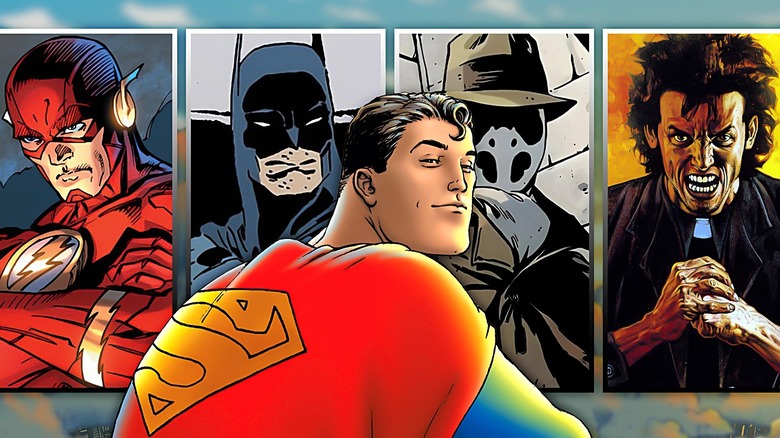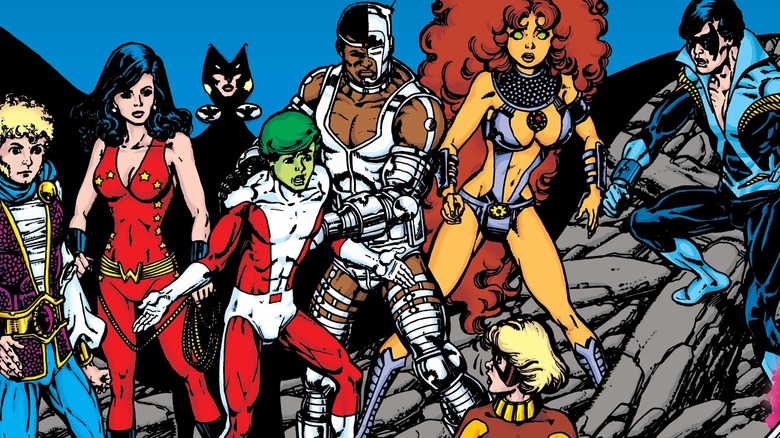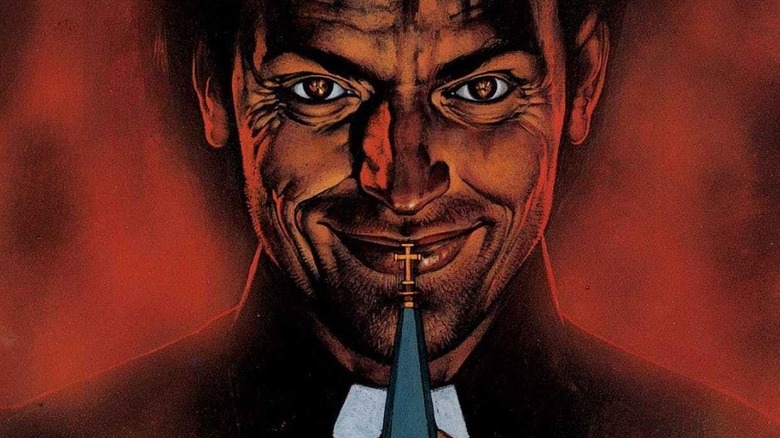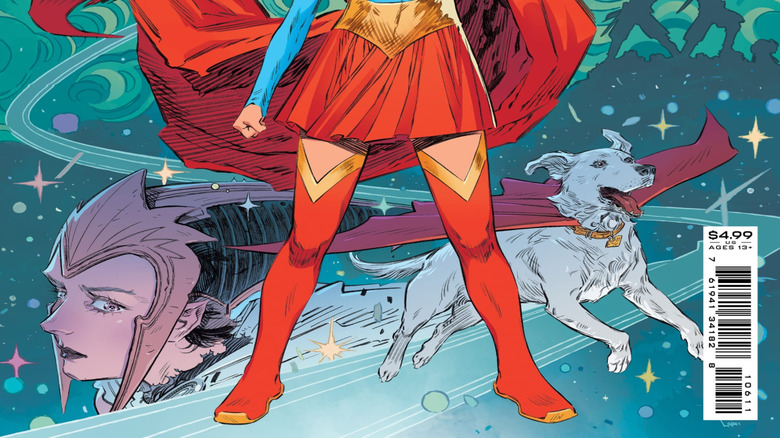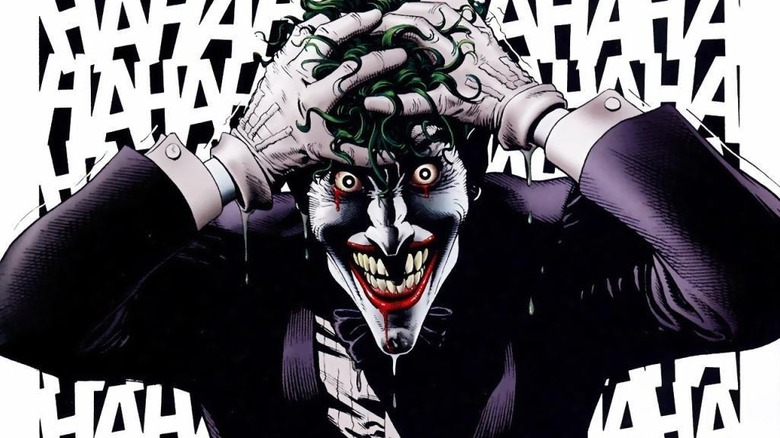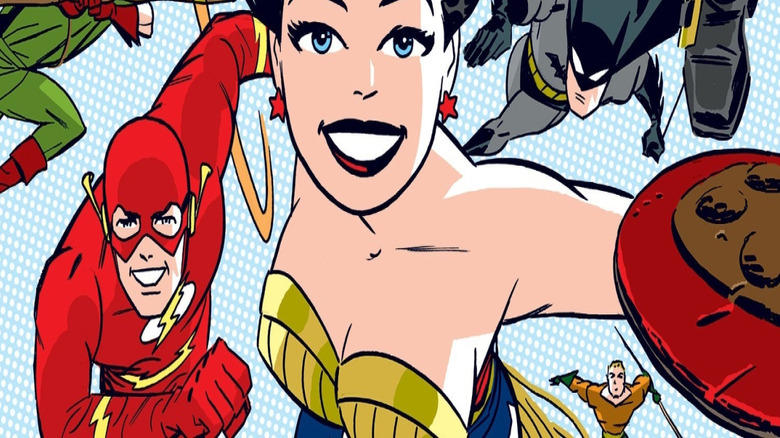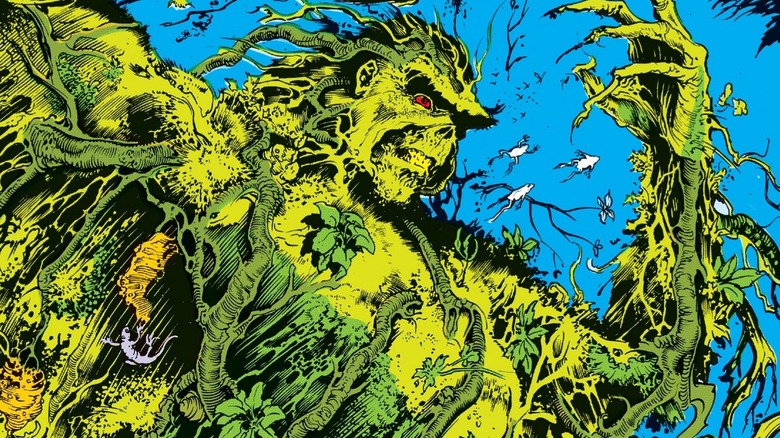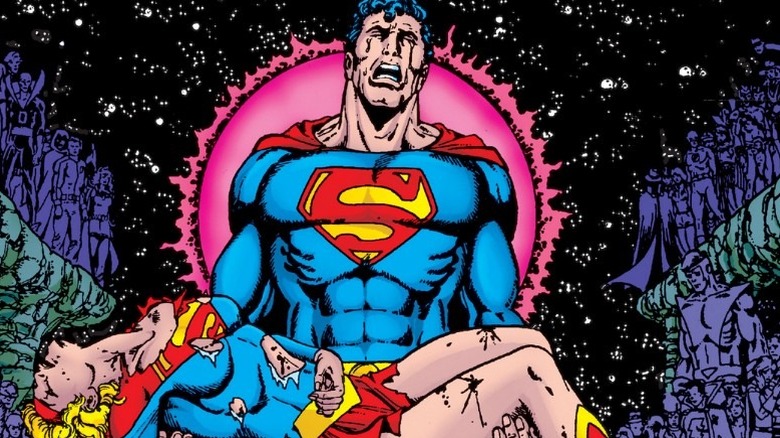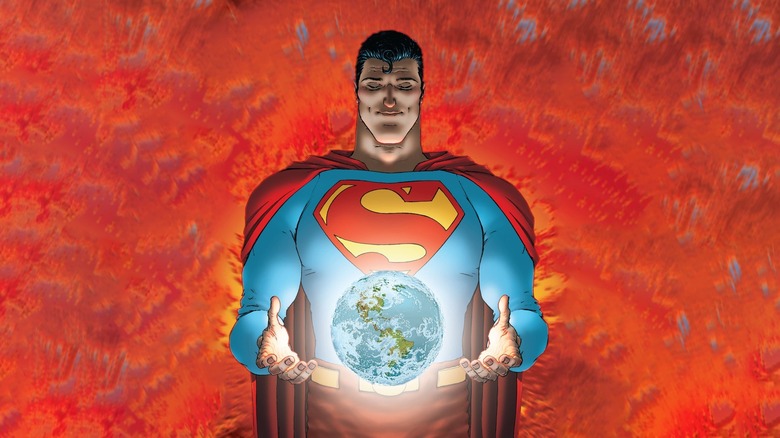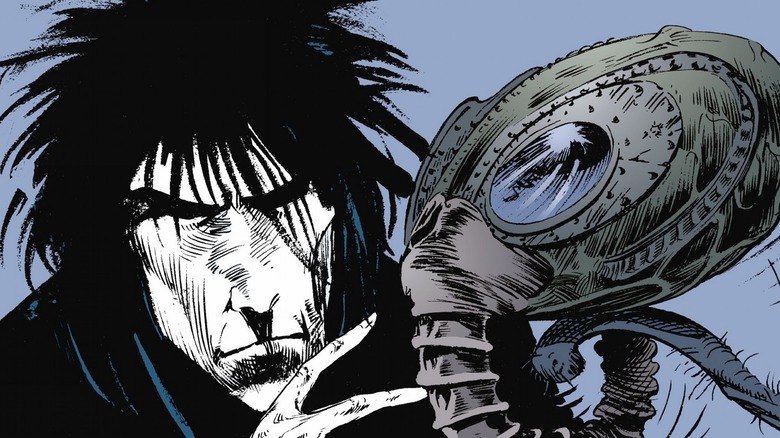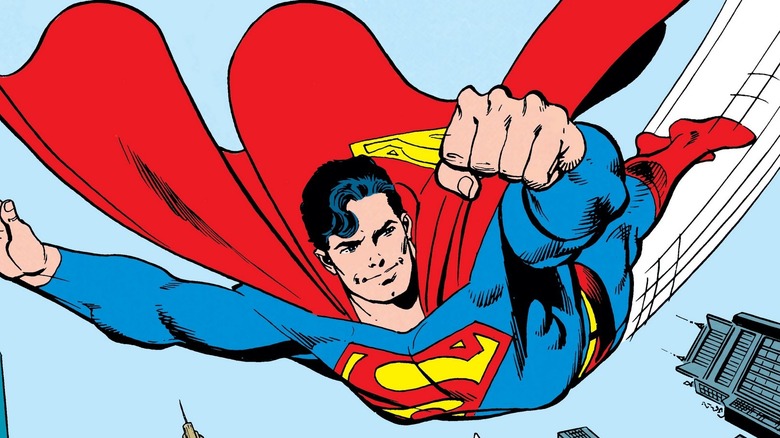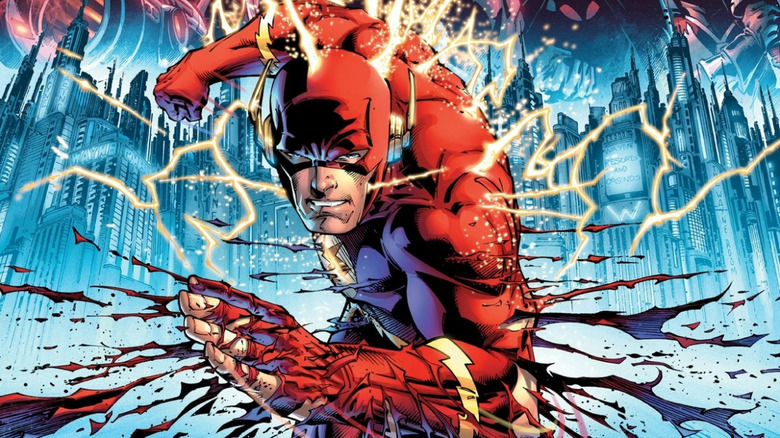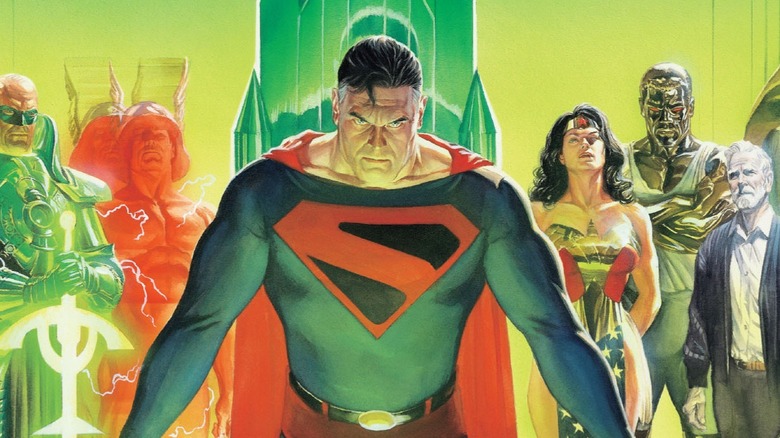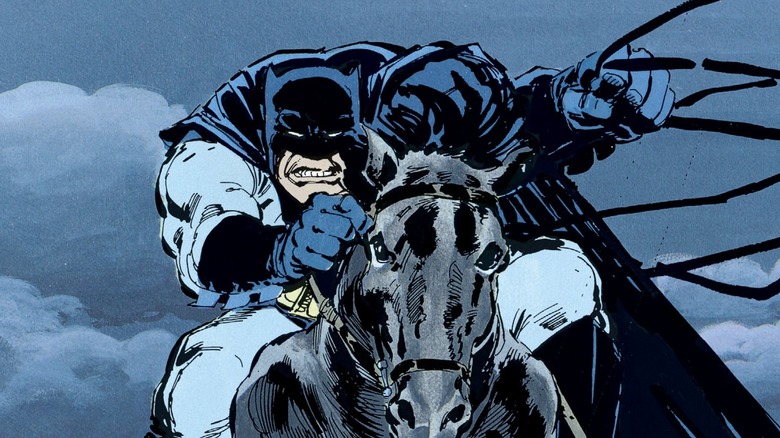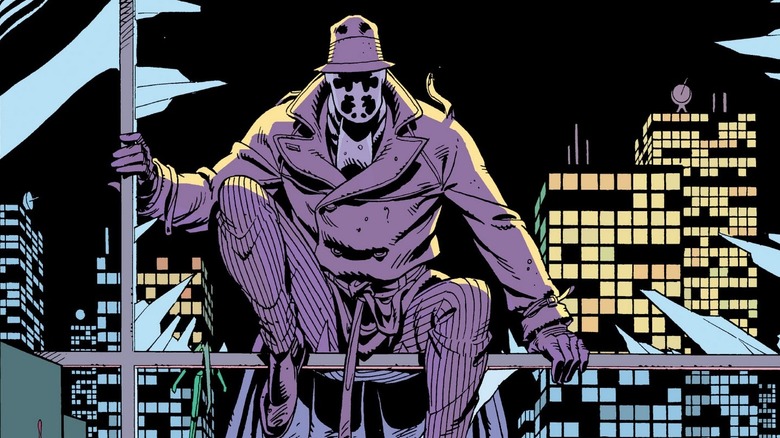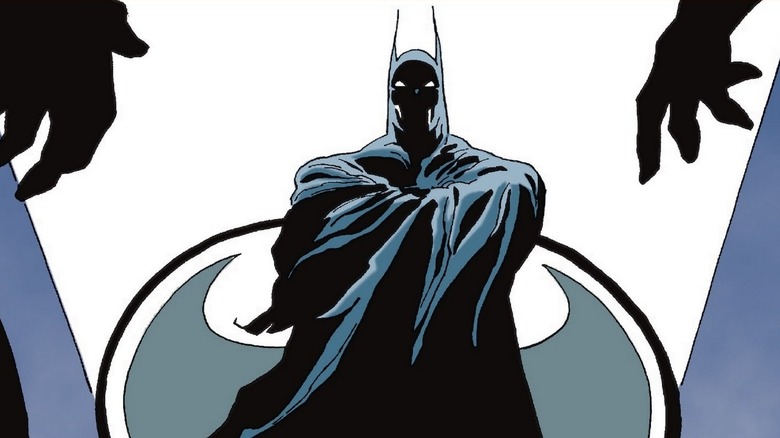15 Best DC Comics Ever, Ranked
Don't just say, "Make mine Marvel," because DC Comics — also known as DC — boasts some of the greatest comic book storylines of all time. But do you know how tough it is to select the best of the best here? It's near impossible! From Batman to Superman, each character could fill their own list of all-time hits — and speaking of which, do check out the 20 best Batman comics you need to read.
We love a good challenge at /Film, though — that, or we enjoy the merciless bullying that will follow if we miss out on one of your favorites — so we picked 15 of the best DC Comics ever, based on a meaningful mix of overall quality, lasting influence on the genre, and personal preference. These are the stories that left a mark and made us even bigger fans of comic books in general. With that said, grab the cape, cowl, and cup of coffee, and let's share in the magic of the medium, because comics are good!
15. New Teen Titans: The Judas Contract
Nowadays, Deathstroke stands tall as one of DC's most recognizable antiheroes. In the '80s, though, Slade Wilson terrorized the Teen Titans as their biggest adversary. "New Teen Titans: The Judas Contract" — by Marv Wolfman, George Pérez, and various other creative talents — is a four-part arc that provides a compelling origin story for Deathstroke the Terminator, but it also showcases his most deceptive act yet: infiltrating the Titans through his lover/double agent Terra in an attempt to destroy them once and for all.
While the age-gap love angle between Deathstroke and Terra is weird — and likely criminal in certain states — "The Judas Contract" proves to be a tale that has a significant impact on the Titans, as Deathstroke's complicated past adds nuance to the character and he almost succeeds in ripping the Titans apart. The arc also features a key event in DC history, as readers see Dick Grayson shed his Boy Wonder persona of Robin to become Nightwing. "The Judas Contract" received a decent animated film adaptation that formed a part of the DC Animated Universe, so be sure to check that out too.
14. Preacher
Blasphemy is just a nine-letter word when it comes to "Preacher," which was created by Garth Ennis and the late Steve Dillon. Released under the imprint of Vertigo in 1995 and running for 75 issues, "Preacher" follows Reverend Jesse Custer who's possessed by the supernatural entity known as Genesis that gives him the power known as the "Word of God," which allows him to control others. Armed with this ability and his pals in tow, Jesse seeks out an audience with God.
If you're unfamiliar with Ennis' writing, he's also the scribe behind "The Boys," so know that his tongue is firmly planted in his cheek at all times, and he loves to inject everything with the darkest humor (there's a character named Arseface, for heaven's sake!). "Preacher" contains phenomenal art from Dillon, whose minimalist but expressive style outshines the Rob Liefeld clones of the era who valued warped feet and so many pockets on their characters. Sure, "Preacher" is an acquired taste, but it's punk rock to the core and inspired the next generation of talent to look past superheroes as the be-all and end-all of comics.
13. Supergirl: Woman of Tomorrow
One of the newest entries here is 2021's eight-issue series "Supergirl: Woman of Tomorrow," from Tom King, Bilquis Evely, and Mat Lopes. This sprawling cosmic adventure sees Kara Zor-El question her purpose and whether her efforts make any positive change to the world. Her answer arrives when a young alien girl Ruthye Marye Knoll needs Supergirl's help to seek out justice, so off Supergirl goes into space with Ruthye and Krypto to renew hope in a darkened world.
"Supergirl: Woman of Tomorrow" turned out to be an instant classic, exploring Supergirl through a different lens and unlocking all that makes her different from her cousin, Kal-El. Like with his previous work, King taps into the trauma behind the character, discovering her greatest fears and biggest regrets while humanizing this almighty Kryptonian and making her more relatable. The comic book series also serves as the main inspiration for Craig Gillespie's "Supergirl: Woman of Tomorrow" movie, which features a harsher, more messed-up hero than Superman.
12. Batman: The Killing Joke
Who is the Joker? That's a good question that may never be answered due to the duplicitous nature of the fiend. In "Batman: The Killing Joke," a 1988 one-shot by Alan Moore and Brian Bolland, the "origin story" of the Joker gets intertwined in between one of the Clown Prince of Crime's most vile crimes as he shoots Barbara Gordon, takes pictures of her in various states of undress, and attempts to mentally break down her father, James Gordon. It's up to Batman to stop the maniacal prankster in a heart-stopping psychological thriller that exposes how the Ace of Knave's true story may never be known, because he prefers multiple choice retellings of the one bad day that sent him down the path of villainy.
"Batman: The Killing Joke" remains a controversial DC storyline because of the disturbing narrative, with some heralding it as a masterpiece while others think it crosses the line of decency. Heck, even Bruce Timm dreaded making "Batman: The Killing Joke" into a movie. Love it or hate it, there's no denying it's a quintessential Joker story that's shaped how the rogue is now seen in popular culture.
11. DC: The New Frontier
The late Darwyn Cooke possessed a '50s-inspired visual style, drawing influence from cartoons, comics, and advertising of the era. Yet, his work also holds a timeless quality that resonates with the reader, regardless of the decade. In 2004's six-issue miniseries "DC: The New Frontier," Cooke crafted a story that sees the Golden Age collide with the Silver Age, as DC's Trinity — Batman, Superman, and Wonder Woman — cross paths with the Green Lantern, Aquaman, Flash, and various other heroes. Cooke swung for the fences with this ambitious story, providing social commentary of the changing times and the role of superheroes across the ages.
By no means is "DC: The New Frontier" a breezy read, but it's the type of story that if you invest the time and concentration into it, it'll reward you with an adventure that breaks new ground about what's possible in the medium of comics. The series received a phenomenal film adaptation titled "Justice League: The New Frontier," which was voted by the /Film team as one of the 10 best DC animated movies.
10. Saga of the Swamp Thing
When Alan Moore took over the reins of "Saga of the Swamp Thing" in the '80s, he and his creative team redefined the character beyond being a botanical-themed hero with swamp butt (presumably). No longer was Swamp Thing the story of Alec Holland who becomes one with nature after an explosion. In this version, Holland dies in the fire, but the Elemental being known as Swamp Thing absorbs Holland's consciousness and memories, believing itself to have been human at one point. It isn't, nor has it ever been, though.
"Saga of the Swamp Thing" falls firmly in the horror category, leaving behind the superhero-esque nature of past stories and embracing monster roots instead. Moore doesn't only spook, but he also provides food for thought about a number of pertinent ecological and social issues relevant to the decade and even now. "Saga of the Swamp Thing" turns out to be a mature read that pushes the character into uncharted territories, while its undisputed influence also lingers in every drop of the bayou from the "Swamp Thing" television show that was unfairly and quickly cancelled.
9. Crisis on Infinite Earths
If there's one thing that fans have learned about DC Comics is that there's always a "crisis" around the corner. Usually, this is the code word for reboot. Released between 1985 and 1986, the "Teen Titans" brain trust of Marv Wolfman and George Pérez helmed "Crisis on Infinite Earths." This year-long event kicks off with the Anti-Monitor destroying various Earths in the multiverse. After the Monitor is killed, the onus falls on the Spectre to gather both heroes and villains from across the DC Universe to take on the Anti-Monitor and to create a single unified Earth where everyone thrives.
Unlike a lot of major comics events that change absolutely nothing in the grand scheme of things, "Crisis on Infinite Earths" is one of the greatest resets in the history of DC. Plus, the creative team didn't hold back in the high-stakes department pulling the ultimate "Red Wedding," as big heroes like Supergirl and Barry Allen's Flash all died in battle, and it would be many years until they returned to the pages of the comics. The CW's Arrowverse also did its version of "Crisis on Infinite Earths," though it differs greatly from the source material.
8. All-Star Superman
One of the best DC Comics ever is Grant Morrison, Frank Quitely, and Jamie Grant's "All-Star Superman," which ran for 12 issues from 2005 to 2008. This Man of Steel story offers something different from others, as Kal-El comes to terms with the fact that the end is near for him after massive exposure to solar radiation weakens his body. In typical Superman style, though, he doesn't mope around about the inevitable; instead, he becomes the ultimate symbol of goodness and embarks on the "Twelve Labors of Superman" whereby he strives to leave the world in a better place than he found it.
From Quitely's distinct art style and understated attention to detail to Morrison's intelligent musings about mortality, "All-Star Superman" soars high as one of the best Superman stories you need to read. It's become a favorite of many people, including filmmaker James Gunn who used it to inform his own 2025 "Superman" movie, while the film's star, David Corenswet, admitted he turned to the pages for inspiration on his performance as Big Blue.
7. The Sandman
The original run of "The Sandman" ran for 75 issues between 1989 and 1996. Released under the DC imprint of Vertigo, the dark fantasy series, written by Neil Gaiman, features an abundance of acclaimed artists, such as Sam Kieth, Jill Thompson, Mike Dringenberg, and Dave McKean, bringing their deft touches to this original world. "The Sandman" turned out to be a key fork-in-the-road moment in comic book history too, as it brought literary prestige to the medium, gaining widespread recognition for its exceptional and mature writing of complex topics.
The story follows Dream, one of the Endless who is responsible for the realm of dreams and everything that isn't real. He has many names and taken various forms, but he fights to reclaim his kingdom after being held captive for decades. Dream holds a complicated relationship with his other powerful siblings from the Endless, but the real strength of "The Sandman" lies in how Gaiman and Co. tackle emotional and ethereal topics, such as death. The comic book received a live-action adaptation, but there are some big differences between Netflix's "Sandman" and the original comic.
6. Superman: The Man of Steel
After "Crisis on Infinite Earths," DC characters received refreshed origin stories. Superman's came in the form of John Byrne and Dick Giordano's 1986 six-issue miniseries "Superman: The Man of Steel." Nowadays, this story is often considered the definitive origin for Kal-El, as it slightly adjusts the backstory from before to make him the Last Son of Krypton and his journey to discover his true heritage. In addition, other supporting characters, such as Lex Luthor, get upgrades to their narratives, as Lex goes from evil scientist to evil business tycoon — an aspect that has stayed with modern-day interpretations of Lex.
While DC couldn't leave well enough alone and added more layers to the origin in later years (it's comics, people — canon is more flexible than a possessed Regan MacNeil from "The Exorcist"), "Superman: The Man of Steel" proves to be the best jumping-on point for any new or unfamiliar fans of the character. It simplifies who he is, what he stands for, and why he's considered one of the greatest superheroes of all time. What more could you want?
5. Flashpoint
Another one of the best DC Comics ever is 2011's "Flashpoint" by Geoff Johns, Andy Kubert, and various other creative talents. In this story, Barry Allen wakes up to find everything around him is radically different. For example, Thomas Wayne is Batman — not Bruce Wayne — while the Amazons and Atlanteans find themselves in a bloody war that threatens to tear the world apart. Soon, Barry discovers that this alternate reality was caused by his nemesis Reverse-Flash, so he must figure out a way to change the timeline to how it should be.
"Flashpoint" is a fan-favorite story arc, because of how it momentarily changes the status quo of the DC Universe and asks a variety of what-ifs. Look at the case of Batman for instance. Instead of Thomas and Martha Wayne dying in the alley that fateful night, it was Bruce, and this set off his parents on different trajectories. "Flashpoint" also inspired "The Flash" movie, though the cinematic adaptation didn't stick as close to the source material as some fans may have hoped for.
4. Kingdom Come
In 1996, Mark Waid and Alex Ross teamed up for the four-part miniseries "Kingdom Come." Hands down, it's one of the most beautiful comic books you'll ever own, because it's Ross at his absolute best, and no one turns superhero comics into paintings that should be hung in the Louvre quite like he does. The story, though, is equally magnificent, as Waid ponders a reality where the new protectors cross various lines under the guise of heroism. This results in the old guard — featuring Superman, Wonder Woman, and Batman — having to come out of retirement to remind everyone what heroes truly should be and stand for.
In fandom, there's often a running debate about how far superheroes should be allowed to go for the sake of humanity. "Kingdom Come" makes a compelling case that when heroes go too far, that makes them no different than the villains they fight. Ultimately, this tale evolves into a discussion about morality and doing the right thing — especially in the face of adversity and when it's easier to lose your moral compass. Also, can we agree that the Spectre is the next DC superhero who deserves a movie?
3. The Dark Knight Returns
Frank Miller has produced a few seminal Batman stories, but his work in 1986's "The Dark Knight Returns" alongside Klaus Janson and Lynn Varley remains one of the most influential of all time. It didn't only change the way that fans viewed Batman, but it resulted in the industry growing up quickly and accepting more mature takes on popular superheroes.
In this story, Bruce Wayne is 55 years old and retired from cape duties. However, Gotham City soon goes to the dogs, being overrun by the gang known as the Mutants. So, Bruce suits up, gains a new Robin in the form of Carrie Kelley, and faces off against many familiar faces from the past, even though the U.S. government isn't the biggest fan of the Dark Knight's controversial methods.
Often heralded as one of the best comic book stories of all time, "The Dark Knight Returns" served as major influence for Zack Snyder's "Batman v Superman: Dawn of Justice." It's also the book that finally helped Batman to shake off the campy vibes that stuck to him like glue after the 1966 television series.
2. Watchmen
Created in 1986 by Alan Moore, Dave Gibbons, and John Higgins, "Watchmen" both satirizes and deconstructs the superhero genre. The story is set in an alternate reality where superheroes influenced real-life events, such as the Vietnam War. With global tensions mounting, though, the heroes have been outlawed or work as government agents. A web of mystery unfolds after the death of one of the Watchmen points to a conspiracy that runs deeper than anyone might have imagined.
"Watchmen" is a thematically rich and sophisticated story. There are layers upon layers that often only reveal themselves after multiple reads and extra attention paid to the panels. It's also an interesting conundrum, since Moore wrote it as a condemnation of what comics was becoming at the time, but many missed the satire aspect of it. Yet again, it's a reminder of how people perceive art differently. For years, the story was deemed unfilmable, but Zack Snyder's 2009 "Watchmen" film has been seen as a best-case scenario for anyone trying to adapt the comic.
1. Batman: The Long Halloween
Jeph Loeb and Tim Sale's "Batman: The Long Halloween" isn't one of the best DC Comics ever — it's the best. Hear me out here. The 1996 13-issue series explores the mystery of a killer known as Holiday, who strikes on — you guessed it — holidays. While that's the general premise of the story, "The Long Halloween" turns Gotham City into its own character, examining the turning tides of the city's criminal underworld with the arrival of Batman and various supervillains.
Even though "The Dark Knight Returns" might be credited as the story that shifted the public's perception about Batman, the influence of "The Long Halloween" seeps into every facet of the character today. It isn't difficult to see traces of the comic in Christopher Nolan's "The Dark Knight" trilogy, or even more obviously in Matt Reeves' "The Batman," which starts off on Halloween. This hard-boiled and cerebral comic book story feels like it could be straight out of the mind of David Fincher, as it draws the reader in for the long haul and showcases Batman's superior detective skills. "The Long Halloween" has received a few decent sequels over the years, but the original series remains the crown jewel in DC's history.
